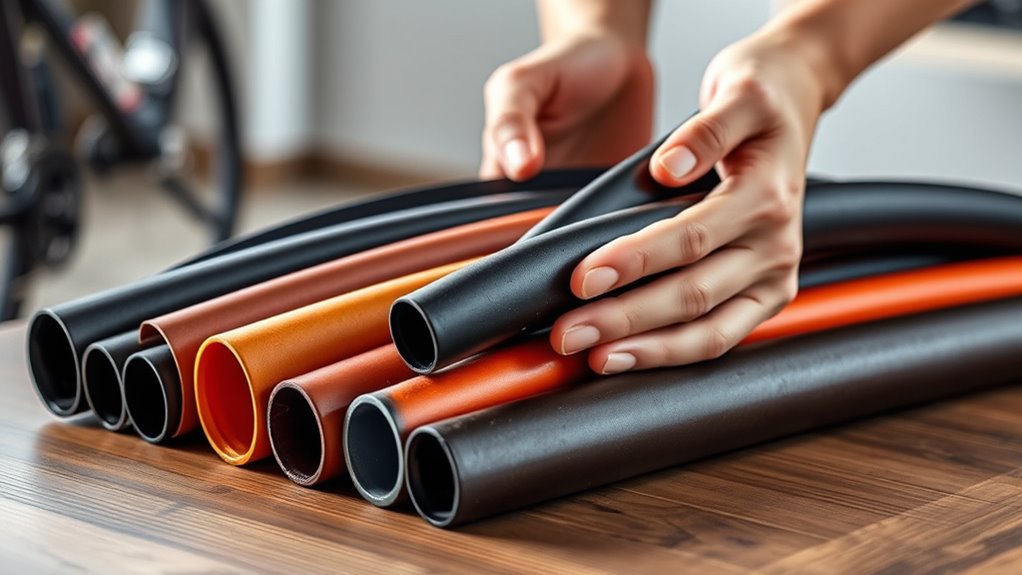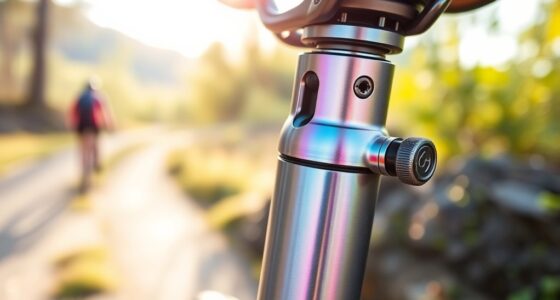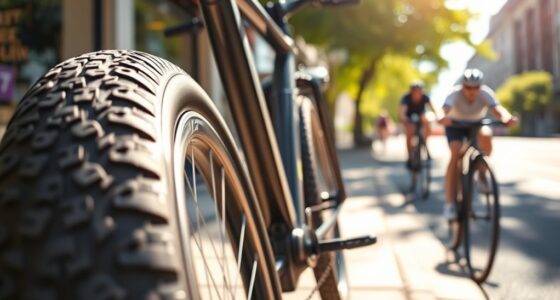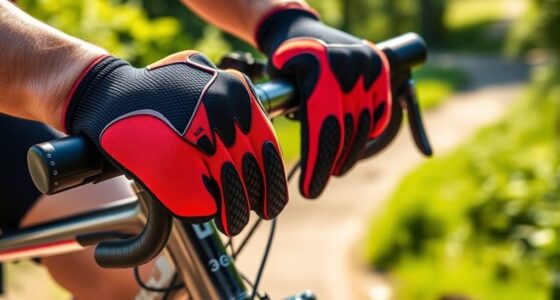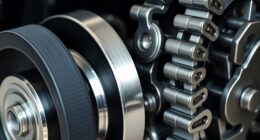When I think about the best bike tubes for durability, the Ultraverse Bike Inner Tube stands out for its puncture resistance and convenience. The Bell Standard and the self-sealing options are also great for those worried about flats. If you’re into lightweight gear, the Thinvik TPU tubes are ideal. With so many choices, I’m excited to share my top picks that cater to every cyclist’s needs. Stick around, and you’ll uncover even more insights on finding the perfect tube for your ride.
Key Takeaways
- Choose butyl rubber tubes for superior air retention and puncture resistance, ensuring longer-lasting performance on various terrains.
- Opt for seamless construction and mold-cured vulcanization to enhance durability and minimize the risk of blowouts.
- Reinforced valve stems provide added protection against breakage, essential for maintaining air pressure during rides.
- Consider self-sealing tubes with effective sealants to prevent punctures and slow leaks for up to two years.
- Evaluate customer feedback to identify potential quality control issues and ensure reliable performance from your selected bike tubes.
Ultraverse Bike Inner Tube for 26 Inch Bicycle Tire (2 Pack)
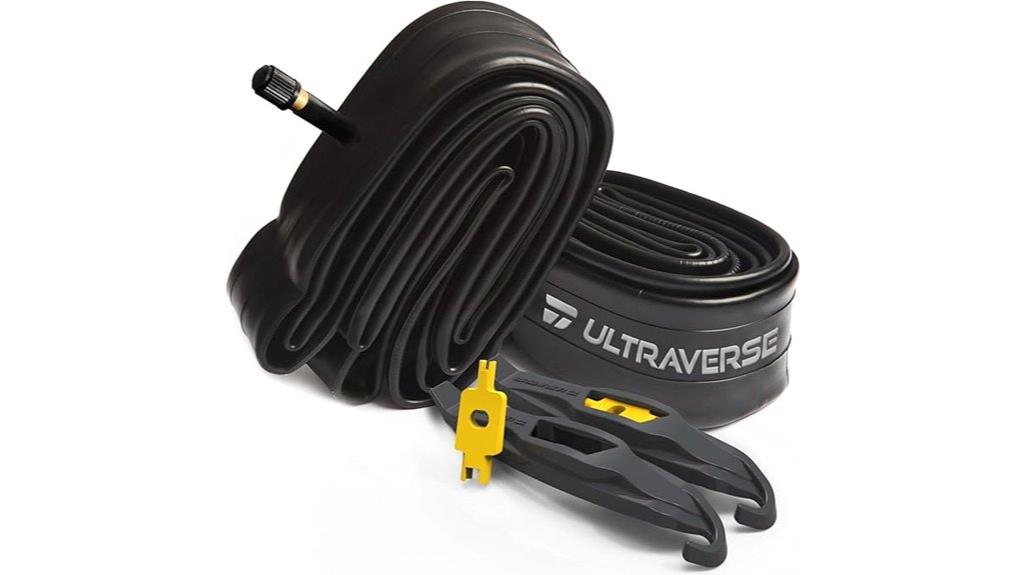
If you’re an avid cyclist looking for reliability on your rides, the Ultraverse Bike Inner Tube for 26-inch bicycle tires is a fantastic choice. These inner tubes, made from durable butyl rubber, are designed to resist punctures while maintaining air pressure longer thanks to their thicker walls. I love that they come in a two-pack, perfect for mountain, trail, or city biking. The reinforced Schrader valve adds extra protection against breakage. With an average rating of 4.5 stars from over 1,400 reviews, many users praise their quality and ease of installation. Overall, they’re a solid investment for any cyclist!
Best For: Avid cyclists who ride mountain, trail, or city bikes and need reliable inner tubes for their 26-inch tires.
Pros:
- Durable butyl rubber construction resists punctures and maintains air pressure longer.
- Comes in a convenient two-pack, making it easy to replace or keep a spare on hand.
- Reinforced Schrader valve provides additional protection against breakage during installation and use.
Cons:
- Some users have raised concerns about durability and structural integrity over time.
- A few customers reported difficulty with installation despite the included tools.
- Limited compatibility with tire widths outside the specified range of 1.75 to 2.13 inches.
Bell Standard and Self Sealing Bike Tubes

For cyclists seeking a reliable, durable option, Bell Standard and Self Sealing Bike Tubes stand out as an excellent choice. I’ve found their mold-cured rubber effectively prevents high-pressure blowouts, making them a dependable option for both cruiser and mountain bikes. Installation is a breeze; I simply removed the tire, replaced the tube, and inflated it without hassle. While some users reported issues with blowouts, my experience has been positive, with tubes holding up well under various conditions. Overall, I appreciate the cost-effectiveness and quality of these tubes, and I’d definitely recommend repurchasing them for future rides.
Best For: Cyclists looking for a reliable and durable inner tube option for cruiser and mountain bikes.
Pros:
- Cost-effective with high-quality performance and durability.
- Easy installation process, making it user-friendly for all cyclists.
- Effective sealant that helps prevent punctures and slow leaks.
Cons:
- Some users reported blowouts shortly after installation.
- Valve stem length may not be suitable for all deep rim setups.
- Perceived as heavier compared to other brands, which may not appeal to all cyclists.
Bike Inner Tube with Slime Puncture Sealant
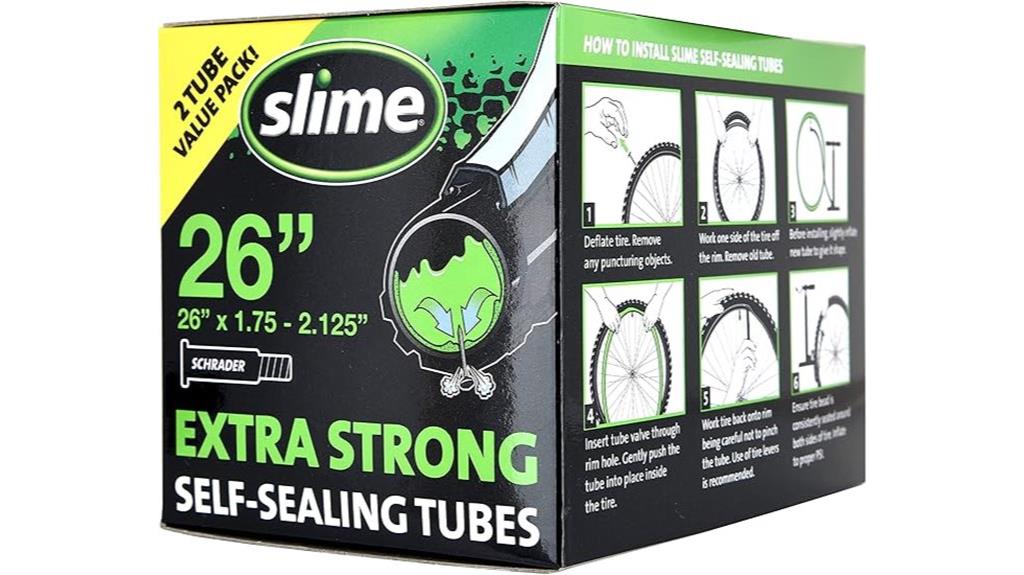
The Bike Inner Tube with Slime Puncture Sealant stands out as a top choice for mountain bikers who want to ride without the constant worry of flats. Its extra strong, self-sealing design can prevent punctures for up to two years, sealing holes up to 1/8 inch thanks to its Fibro-Seal Technology. Installing it is a breeze, just like any traditional Schrader valve tube. Plus, it’s environmentally friendly. While it may not seal every small puncture, it definitely keeps you rolling in rough conditions. I appreciate the peace of mind it gives, making my rides more enjoyable and stress-free.
Best For: The Bike Inner Tube with Slime Puncture Sealant is best for mountain bikers looking for a reliable solution to prevent flats during their rides.
Pros:
- Easy installation, suitable for users with no prior experience.
- Effectively seals punctures up to 1/8 inch, providing peace of mind during rides.
- Environmentally friendly, non-toxic, and offers a two-year warranty.
Cons:
- May not seal all punctures, especially from fine debris.
- Heavier than standard tubes, which could be a drawback for racing.
- Some users report issues with valve clogging affecting inflation.
Thinvik TPU Inner Tube for Road Bike and MTB (2 PCS)
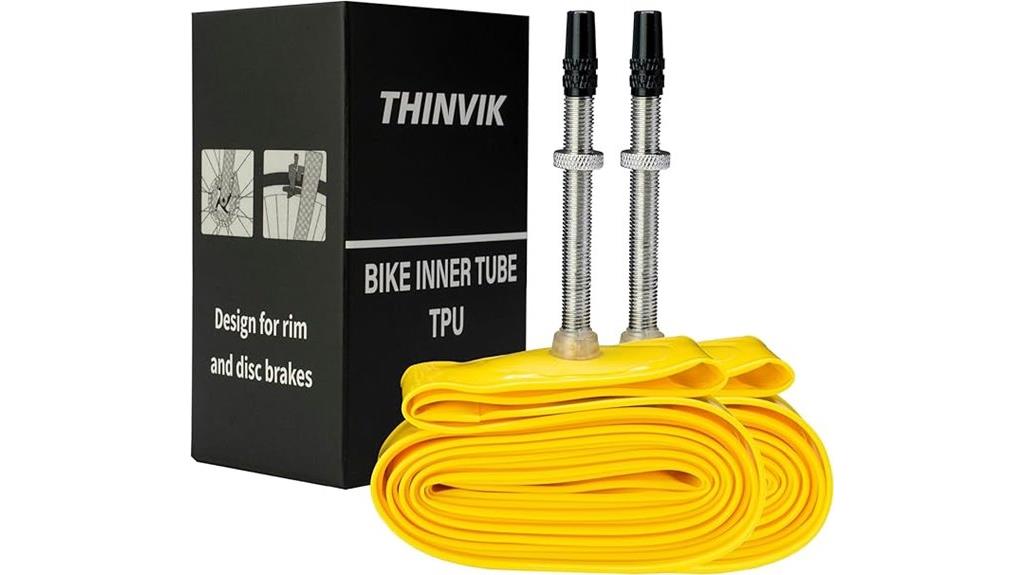
Designed with versatility in mind, the Thinvik TPU Inner Tube is an excellent choice for anyone riding road bikes, mountain bikes, or gravel bicycles. Weighing in at about 70% less than traditional butyl tubes, they’re a breeze to carry as spares. The upgraded plastic valve stem with metallic threads enhances durability, making installation easier with their longer and thicker design. While many users enjoy the lightweight feel and improved pedaling, some report issues with flats and punctures. I’d recommend these tubes for light use or as backups, but keep in mind the mixed reviews on durability.
Best For: Casual cyclists looking for lightweight inner tubes as spares for road, mountain, or gravel biking.
Pros:
- Lightweight design: Approximately 70% lighter than traditional butyl tubes, making them easy to carry.
- Durable valve stem: Upgraded plastic valve with metallic threads enhances longevity and sturdiness.
- Ease of installation: Longer, wider, and thicker design simplifies the installation process.
Cons:
- Potential durability issues: Some users report flats and punctures, raising concerns about long-term reliability.
- Challenging to patch: Repairing TPU tubes can be difficult, leading to frustration for some users.
- Mixed performance reviews: While some enjoy them, others advise caution due to inconsistent experiences.
2-PCS 20 Bicycle Tubes Compatible with 20×1.75 to 20×2.125
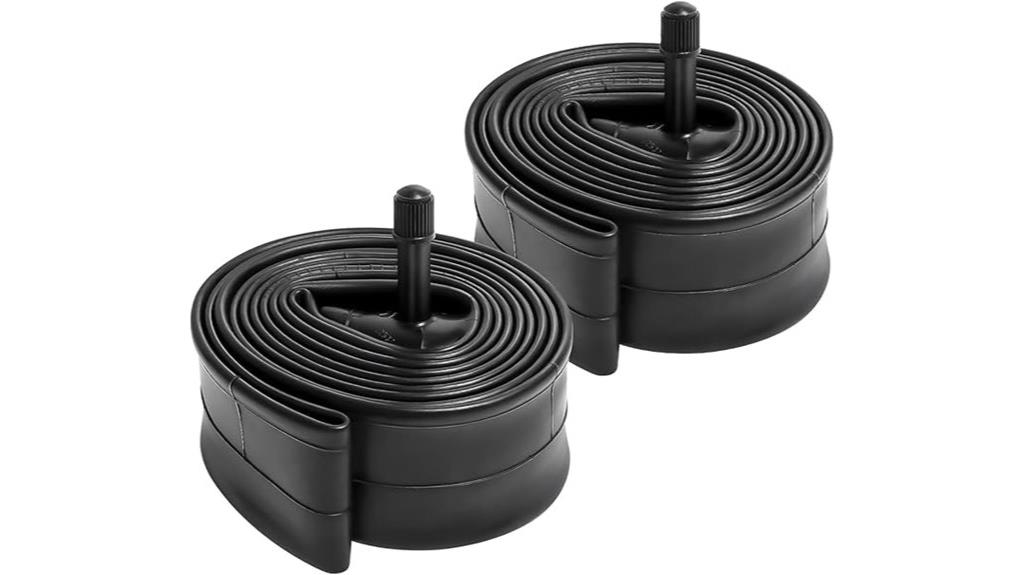
If you’re looking for reliable bike tubes that can handle various riding conditions, the PCS 20 Bicycle Tubes are an excellent choice. These tubes fit tire sizes from 20×1.75 to 20×2.125 and feature a durable butyl rubber construction, ensuring better sealing and resistance to wear. I love how easy they are to install, making quick replacements a breeze. With a solid customer rating of 4.5 stars, many users praise their quality and performance. Plus, they come with a 180-day quality guarantee, giving you peace of mind. Overall, they’re perfect for road, mountain, and BMX bikes.
Best For: Casual riders and enthusiasts looking for reliable, easy-to-install bike tubes for road, mountain, or BMX bikes.
Pros:
- Durable butyl rubber construction ensures better sealing and resistance to wear.
- Quick and easy installation for hassle-free tube replacement.
- Solid customer rating of 4.5 stars, indicating high satisfaction among users.
Cons:
- Some reports of defects in individual tubes may occur.
- Limited to specific tire sizes (20×1.75 to 20×2.125), which may not fit all bikes.
- Warranty requires relevant pictures and information for quality issues, which may be inconvenient.
Continental Cross Bicycle Inner Tube Bundle (4 Pack)
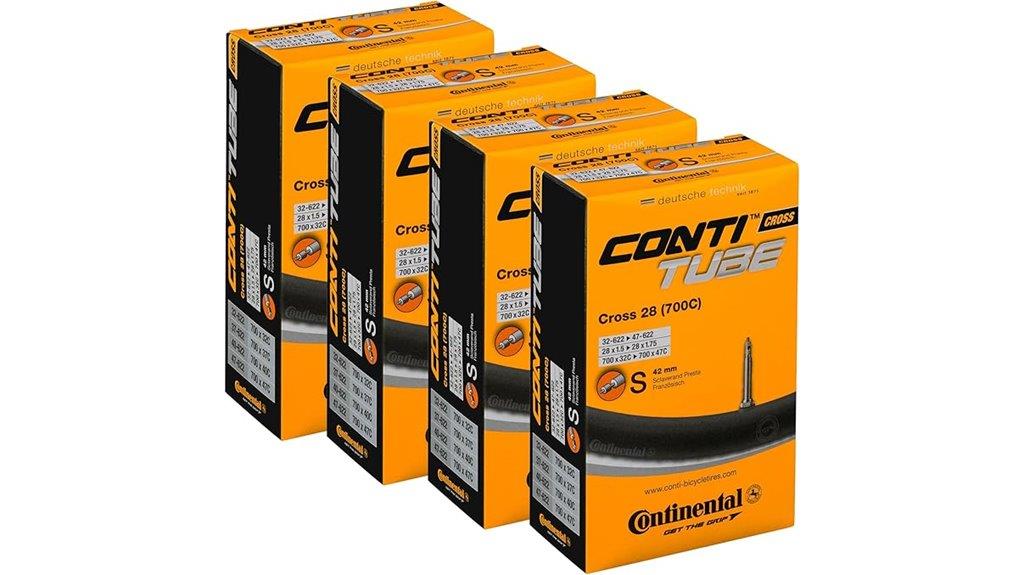
For anyone who commutes daily or tackles rough terrain, the Continental Cross Bicycle Inner Tube Bundle (4 Pack) stands out as an excellent choice. These 700×32-47c tubes weigh around 170g each and feature a 42mm Presta valve. I’ve found them incredibly firm and durable, perfect for rough roads. They hold air well and resist punctures, making them reliable for long rides. Plus, the removable valve cores let you add sealant for even better performance. At about $5 per tube, it’s a fantastic value compared to local shops. Just remember to check for leaks before installation!
Best For: Daily commuters and cyclists who tackle rough terrain and seek reliable, puncture-resistant inner tubes.
Pros:
- Removable valve cores allow for easy addition of sealant, enhancing air retention and performance.
- Durable construction resists punctures and holds air well, ensuring a reliable ride.
- Great value at approximately $5 per tube, significantly lower than local shop prices.
Cons:
- Some users report cheap plastic valve caps that may break easily.
- There may be instances where the advertised Conti sticker is not included in the pack.
- It’s recommended to check for leaks by inflating all tubes prior to installation, which may be an extra step for some users.
Continental Bicycle Tubes Race 28 700c (5-in-1 Value Bundle)

Cyclists looking for reliability and value will appreciate the Continental Bicycle Tubes Race 28 700c (5-in-1 Value Bundle). This pack includes five tubes, each equipped with a 42mm Presta valve, designed to fit 700×20-25mm tires. Their seamless construction guarantees a solid fit and good air retention, which I’ve found essential for long rides. While some users report issues with seams leaking, I’ve had a positive experience overall. If you’re in need of backup tubes for punctures, this bundle offers great value. Just a tip: consider buying from local shops to avoid potential quality control concerns.
Best For: Cyclists seeking reliable backup tubes for punctures at a reasonable price.
Pros:
- High-quality seamless construction ensures a secure fit and good air retention.
- Pack of 5 offers excellent value for money for frequent riders.
- Quick delivery and well-packaged individual tubes enhance overall customer satisfaction.
Cons:
- Mixed reviews on durability, with some users experiencing multiple flats.
- Issues with removable stems causing air loss if unscrewed accidentally.
- Quality control concerns when purchasing online versus local bike shops.
Continental Race 28 Wide Inner Tubes (Pack of 2)
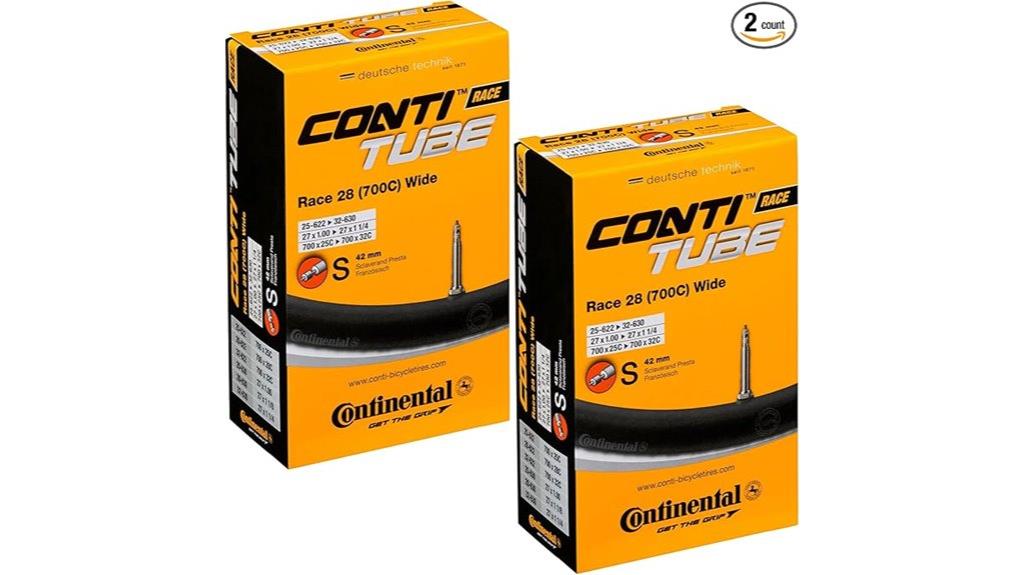
The Continental Race 28 Wide Inner Tubes (Pack of 2) stand out as an excellent choice for avid road cyclists who prioritize durability and reliability. Sized at 700×25-32mm with a 42mm Presta valve, these tubes excel in holding air pressure up to 75psi, ensuring fewer interruptions on rides. The seamless construction and mold-cured vulcanization enhance their longevity, making flats less frequent. I appreciate how easy they are to install, especially when using metal tire levers. Just remember to check compatibility with your rims. Overall, they’re a solid investment for anyone looking to enhance their cycling experience while minimizing downtime.
Best For: Avid road cyclists seeking durable and reliable inner tubes for their bikes.
Pros:
- Excellent air retention with a maximum pressure of 75psi, reducing the likelihood of flats.
- Seamless construction and mold-cured vulcanization enhance durability and longevity.
- Easy to install with metal tire levers, making the process smoother for cyclists.
Cons:
- Some users have reported receiving defective valves or incorrect sizes.
- Not suitable for larger mountain bike tires, limiting compatibility.
- May require verification of specifications before purchase to avoid issues.
Continental Race 28 Bicycle Inner Tubes (2 Pack)
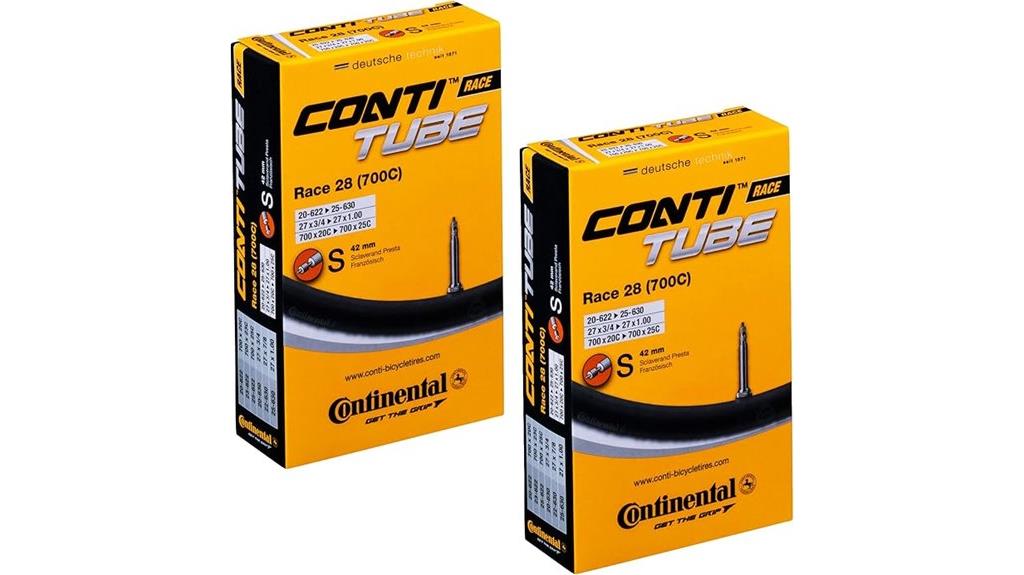
Looking for a reliable inner tube that combines durability and performance? The Continental Race 28 Bicycle Inner Tubes (2 Pack) might be just what you need. With a 42mm Presta valve and a size of 700×20-25mm, these butyl tubes offer a lightweight solution without sacrificing strength. I appreciate the seamless construction and mold-cured vulcanization, ensuring uniform roundness. While some users report installation challenges, many find them easy to set up. I’ve noticed mixed feedback about sizing consistency, but overall, Continental’s reputation for quality and competitive pricing keeps me coming back for more. Give these tubes a try for your next ride!
Best For: Cyclists seeking a durable and lightweight inner tube with a reputation for quality and performance.
Pros:
- Lightweight and durable butyl construction ensures long-lasting use.
- Seamless design with mold-cured vulcanization for consistent roundness.
- Competitive pricing and strong brand loyalty from satisfied customers.
Cons:
- Some users report difficulties during installation, possibly requiring professional help.
- Mixed experiences with sizing consistency, leading to potential incorrect sizes.
- Reports of tubes popping at 75 psi, which may not be an issue with other brands.
Goodyear Bicycle Tube with Butyl Rubber

If you’re in the market for a reliable and durable bike tube, the Goodyear Bicycle Tube with Butyl Rubber stands out with its premium rubber construction. This 12-inch tube offers exceptional puncture protection and is compatible with various mountain bikes, making it versatile for different terrains. I appreciate how easy it is to install, and its design reduces rolling resistance, enhancing my biking efficiency. Many users rave about its air retention, and the pre-filled slime adds extra puncture protection. Despite some mixed durability reports, I find the quick shipping and fair price make it a solid choice for cyclists like me.
Best For: Cyclists seeking a reliable and easy-to-install bike tube suitable for various mountain biking terrains.
Pros:
- Premium butyl rubber construction provides durability and excellent puncture protection.
- User-friendly design allows for quick and hassle-free installation.
- Enhanced biking efficiency due to reduced rolling resistance.
Cons:
- Mixed reviews regarding long-term durability, with some users experiencing failures.
- Some riders may prefer additional features not included, like specialized puncture sealants.
- Availability might vary based on location, affecting quick access for some customers.
HEB Heavy Duty Bike Tube for Ebike Tires
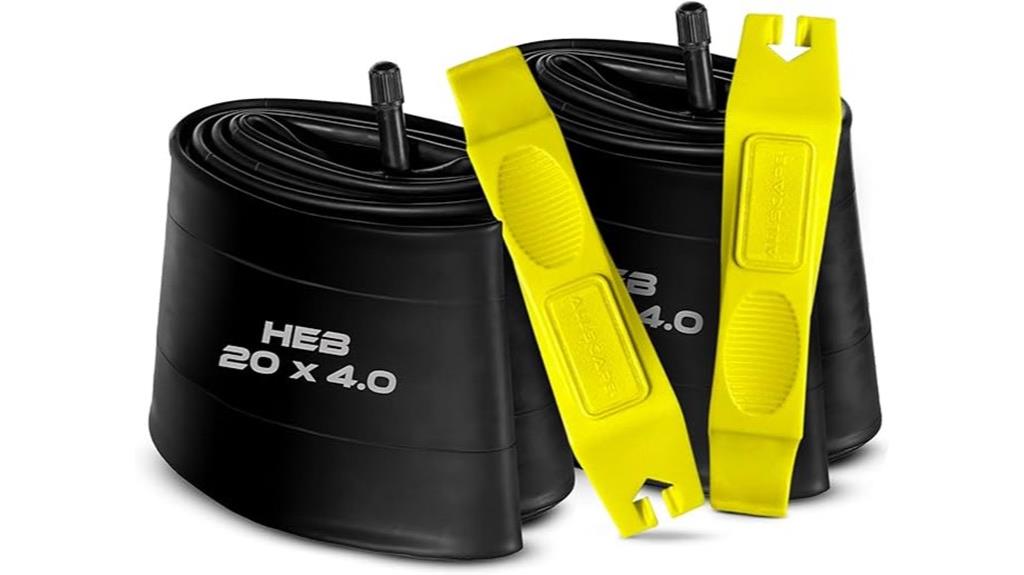
For those tackling rugged terrains on fat tire bikes, the HEB Heavy Duty Bike Tube is a standout choice. Designed for 20×4 and 26×4 tires, this tube offers exceptional durability thanks to its thick butyl rubber material. I love how puncture-resistant it is, protecting me from flats caused by rocks and thorns. It fits perfectly on popular e-bike models like Super 73 and Rad Power Bikes, enhancing traction and stability on backcountry trails. With a solid 4.4-star rating from satisfied customers, I appreciate the ease of installation and the confidence it brings on my rides.
Best For: Those seeking a reliable and durable bike tube for fat tire e-bikes, especially when riding on rugged terrains.
Pros:
- Puncture resistant design protects against flats from rough terrains, ensuring a smoother ride.
- Perfect fit for popular e-bike models like Super 73 and Rad Power Bikes, enhancing bike performance.
- High customer satisfaction with a solid 4.4-star rating, highlighting ease of installation and durability.
Cons:
- Limited size options may not cater to all bike models outside the specified sizes.
- Weight of 0.65 kilograms could add extra heft to the bike compared to lighter alternatives.
- Availability may be restricted to specific retailers, making it less accessible for some buyers.
Continental Tour 28 Presta Valve Tubes (Pack of 2)
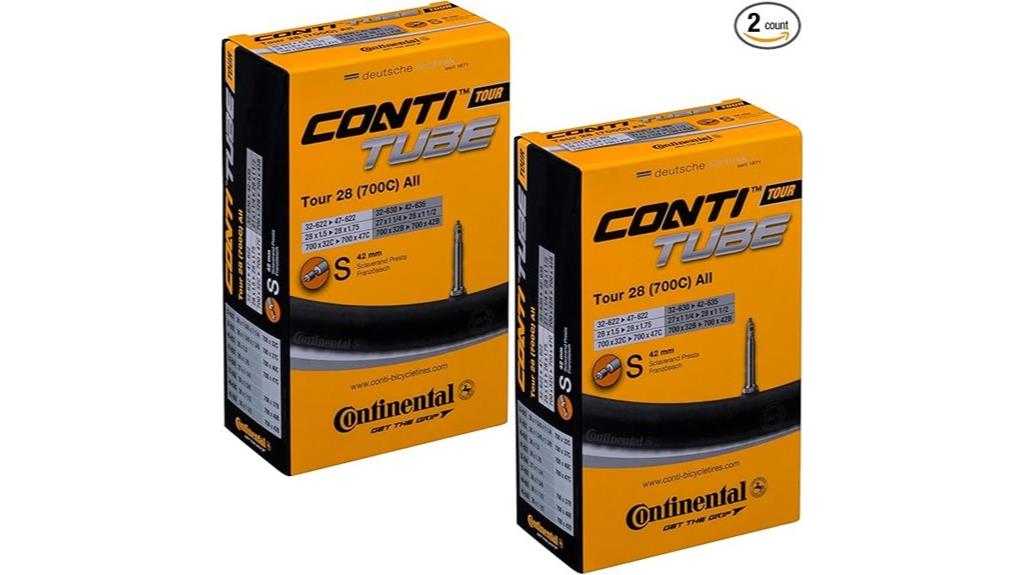
The Continental Tour 28 Presta Valve Tubes are an excellent choice for road cyclists seeking durability and reliability on long rides. Sized at 700×32-47mm, these butyl rubber tubes offer seamless construction with mold-cured vulcanization, ensuring a consistent roundness that enhances performance. I appreciate the 42mm Presta valve, making inflation straightforward. With a solid 4.5-star rating from over 200 users, they’ve proven effective, although I’ve noticed some mixed reviews about valve reliability. Priced affordably, they come in a convenient pack of two, making them a great addition to any cyclist’s gear. Overall, I find them dependable for long journeys.
Best For: Road cyclists looking for durable and reliable tubes for long rides.
Pros:
- Seamless construction with mold-cured vulcanization ensures consistent roundness and performance.
- Affordable pack of two tubes provides great value for cyclists.
- 42mm Presta valve allows for straightforward inflation and compatibility with most pumps.
Cons:
- Mixed reviews regarding valve reliability may raise concerns for some users.
- Notable customer feedback highlights issues with quality control and manufacturing location.
- Limited maximum compatible tire width of 1.85 inches may restrict use for wider tires.
2 Pack of 24 Inch Heavy Duty Bike Tubes with Tire Levers
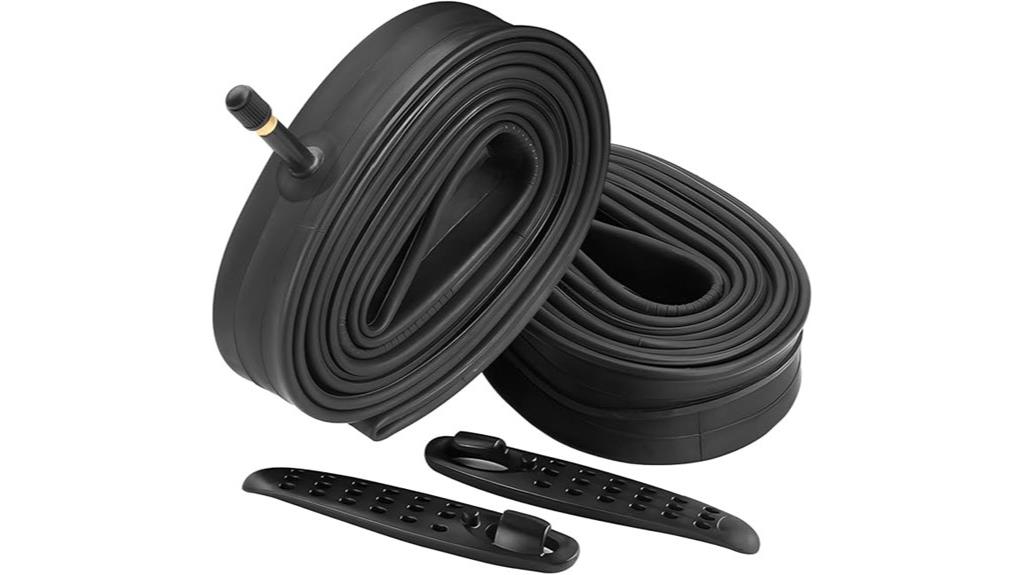
Ideal for avid cyclists and casual riders alike, the Pack of 24 Inch Heavy Duty Bike Tubes with Tire Levers offers exceptional durability and reliability. Made from high-quality butyl rubber, these tubes fit various tire sizes, ensuring versatility for most road and mountain bikes. I appreciate the included tire levers, which are smooth and durable, preventing rim damage during installation. Plus, the detailed instructions make replacing old tubes a breeze. While they lack self-sealing gel for puncture protection, the positive feedback on performance and durability speaks volumes. If you’re looking for quality, this pack is definitely worth considering!
Best For: Avid cyclists and casual riders looking for durable and reliable bike tube replacements.
Pros:
- High-quality butyl rubber material ensures better air tightness and durability.
- Includes tire levers that prevent rim damage and facilitate easy installation.
- Versatile sizing fits a range of tire sizes suitable for most road and mountain bikes.
Cons:
- Lacks self-sealing gel for added puncture protection.
- No option for different valve types; only available with 32mm Schrader valve.
- May require additional puncture protection solutions for frequent riders.
2 Pack Fat Tire Tubes for E-Bike and Bicycle

Looking for reliable fat tire tubes for your e-bike or bicycle? I’ve found the perfect solution with the 2 Pack of 20/26 x 4.0 Fat Tire Tubes. Designed for 26-inch tires, these butyl rubber tubes fit widths from 3.5 to 4 inches. The included tire levers make installation a breeze, preventing finger injuries and protecting your rims. With a 1-year warranty and 100% quality control, I trust their durability. Rated 4.6 stars from satisfied customers, they’re thicker than competitors, minimizing leaks. Whether you need a spare or a flat fix, these tubes won’t let you down.
Best For: Enthusiasts of fat tire bikes and e-bikes looking for durable, easy-to-install replacement tubes.
Pros:
- High durability: Thicker than many competitors, minimizing the risk of leaks and punctures.
- Easy installation: Comes with tire levers that protect fingers and rims during setup.
- Satisfaction guarantee: Backed by a 1-year warranty and a refund policy if not fully satisfied.
Cons:
- Limited compatibility: Only fits specific tire sizes (3.5 to 4 inches wide).
- Weight: At 1.16 kilograms, some may find it heavier compared to standard tubes.
- Valve type: Only available with Schrader valves, which may not suit all bike models.
Hydencamm Bicycle Tube with Tire Levers (2 Pack)
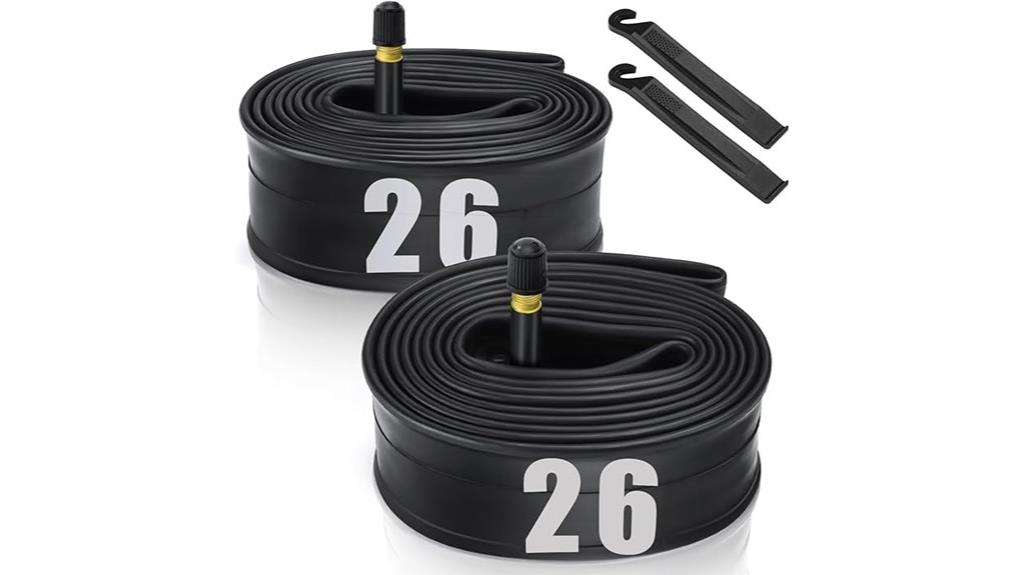
If you’re seeking reliability and ease of installation, the Hydencamm Bicycle Tube with Tire Levers (2 Pack) is an excellent choice for both road and mountain bike enthusiasts. These high-quality butyl rubber tubes fit various sizes, including 26×1.75 to 2.125, ensuring a snug fit. I appreciate the included tire levers, which make the installation process smooth and protect my rims and tubes from damage. With positive reviews highlighting their durability and air retention, I feel confident in their performance. Plus, buying in a 2-pack saves me money and guarantees I’m never left stranded due to a tube failure.
Best For: Cyclists looking for high-quality replacement tubes that are easy to install and compatible with various bike sizes.
Pros:
- Durable construction: Made from high-quality butyl rubber for long-lasting air retention and reliability.
- User-friendly installation: Includes tire levers to simplify the replacement process and protect rims and tubes.
- Cost-effective: Available in a 2-pack, offering additional value and savings compared to local store prices.
Cons:
- Limited size range: While compatible with several sizes, may not fit all bike models or specific requirements.
- Handling caution: Users need to be careful with sharp tools during installation to avoid damage.
- Potential for dissatisfaction: Although refunds are available, some users may still face issues before resolving their concerns.
Factors to Consider When Choosing Bike Tubes for Durability
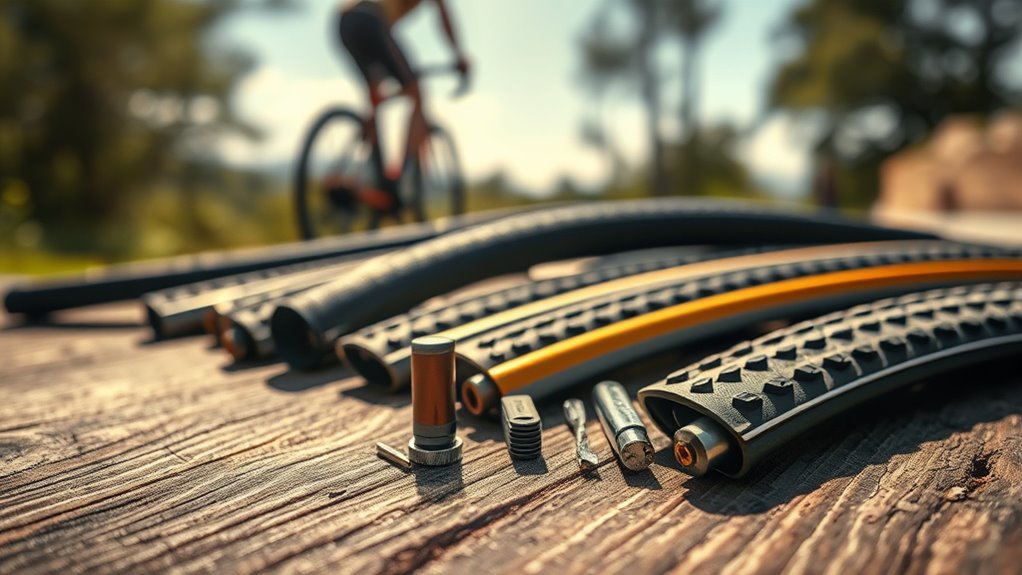
When I choose bike tubes for durability, I focus on a few key factors. Material quality, valve type, and puncture resistance all play an essential role in how long my tubes last. I also consider thickness, weight, and how easy they are to install, since those can make a big difference on the road.
Material Quality and Composition
Choosing the right bike tube can be essential for ensuring durability, especially since the material composition directly affects its performance. I’ve found that butyl rubber tubes are fantastic for air retention and puncture resistance, making them a top choice for many cyclists. I also look for tubes with thicker walls; they handle high pressure better and reduce blowout risks. Reinforced valve stems, particularly metal ones, greatly enhance durability and prevent breakage during inflation. Additionally, I pay attention to environmental factors; tubes that resist ozone and UV degradation last longer. Finally, manufacturing processes like seamless construction and mold-cured vulcanization contribute to a tube’s strength and uniformity, ultimately impacting its longevity on the road.
Valve Type and Reliability
One thing I’ve noticed is how vital the valve type is for bike tubes, especially when it comes to durability and ease of use. Schrader valves are common and easy to find, which makes them a practical choice for many cyclists. On the other hand, Presta valves are lighter and often preferred for higher-end bikes. A reliable valve design minimizes the risk of shearing off, especially reinforced ones that can handle higher pressure. Tubes with removable valve cores allow sealant application, enhancing air retention. Additionally, valve length is important for compatibility with rim depths; the right length prevents air loss and installation issues. I recommend choosing tubes from reputable brands to guarantee quality control and avoid leaks.
Puncture Resistance Features
While evaluating bike tubes, it’s crucial to focus on puncture resistance features that enhance durability. I’ve found that tubes made from butyl rubber are typically more puncture-resistant thanks to their thicker walls and elasticity, which absorb impacts effectively. If you’re worried about flats, consider self-sealing tubes that use sealant technology to close small punctures up to 1/8 inch, greatly reducing flat chances during rides. Additionally, opting for tubes with reinforced valve stems, preferably made from metal, can prevent common shearing failures. For those seeking a lightweight option, new materials like TPU (thermoplastic polyurethane) offer enhanced puncture resistance. Finally, choosing tubes tailored for your bike type, like mountain or fat tire bikes, can boost performance and durability on rough terrains.
Thickness and Weight Considerations
When it comes to selecting bike tubes, finding the right balance between thickness and weight is vital for durability and performance. Thicker walls, like those made from butyl rubber, offer better puncture resistance and protection against blowouts, which is a huge plus for durability. However, I’ve noticed that heavier tubes can increase rolling resistance, potentially impacting speed and efficiency. For added durability, look for tubes with reinforced valve stems, as they help prevent breakage during inflation. Self-sealing tubes are also worth considering; they contain sealant that provides extra protection against flats, though they may add some weight. Ultimately, I believe it’s important to choose a tube that balances thickness and weight to guarantee a smooth ride without sacrificing durability.
Installation Ease and Tools
Choosing the right bike tube isn’t just about durability; it’s also about how easy it is to install. I’ve found that many bike tubes come with tire levers, making the installation process smoother and protecting my rims from damage. The user-friendly designs mean I can replace tubes quickly, even without prior experience. Plus, detailed installation instructions guide me through every step, ensuring I don’t miss anything important. I appreciate that these tubes often highlight compatibility with various tire sizes, so I can easily find the right fit for my bike. Using high-grade rubber not only improves sealing and air retention but also enhances the overall installation experience, making it a breeze to get back on the road.
Compatibility With Tire Sizes
Installing a bike tube is only half the battle; verifying it fits your tire size is just as important. I always check the compatibility of the tube with my tire’s width and diameter, usually specified in inches or millimeters. For example, mountain bikes often use sizes like 26×1.75 to 26×2.125. I also pay attention to the valve type—Schrader or Presta—since this affects how the tube fits my bike’s rim and pump. Using a tube that’s too narrow or wide can lead to punctures, so I verify the inner tube’s specs match the tire’s width range. Finally, I confirm that the tube is appropriate for my bike type, whether it’s a road or mountain bike.
Warranty and Manufacturer Support
While evaluating bike tubes for durability, I always consider the warranty and manufacturer support as key factors. A solid warranty typically covers defects in workmanship and materials, giving me confidence in the product’s quality. I pay close attention to the warranty duration, which can range from a few months to several years, as it often reflects the manufacturer’s faith in their tube’s longevity. Customer feedback on warranty claims also offers insight into how responsive a brand is when issues arise. It’s crucial to read the fine print, as some warranties exclude normal wear and tear. Ultimately, a strong warranty enhances my trust in a product and greatly influences my purchasing decision.
Performance in Various Conditions
When I consider how bike tubes perform in various conditions, I focus on several key factors that influence their durability. The material is vital; I prefer butyl rubber for its puncture resistance and air retention. Thicker walls are another advantage, as they help prevent blowouts on rough terrains. For added peace of mind, I often opt for self-sealing tubes, which can handle punctures up to 1/8 inch, allowing me to get home without hassle. It’s also important to choose tubes specifically designed for my bike type, as they typically offer enhanced puncture resistance. Finally, regular pressure checks and maintenance guarantee my tubes last longer and perform well, no matter the riding conditions.
Frequently Asked Questions
How Do I Properly Inflate My Bike Tube?
Inflating my bike tube properly is essential for a smooth ride. First, I check the recommended PSI on the side of the tire. Then, I attach the pump securely to the valve, making sure it’s snug. I start pumping, watching the gauge closely to avoid overinflation. Once I hit the right pressure, I carefully remove the pump, and quickly cap the valve. Finally, I give the tire a squeeze to confirm it feels firm and ready!
What Tools Do I Need to Change a Bike Tube?
To change a bike tube, I always make sure I’ve got the right tools handy. I need a tire lever, which helps me pry the tire off the rim, and a pump to inflate the new tube. I also keep a patch kit nearby, just in case. Finally, a pair of scissors can be handy for cutting any old tape or remnants. With these tools, I can tackle any tube replacement with confidence!
Can I Use a Bike Tube With a Different Valve Type?
I’ve faced this question before, and the answer’s a bit tricky. While you technically can use a bike tube with a different valve type, it’s not ideal. Mixing valve types can lead to compatibility issues with your pump and rim. I’ve learned that sticking to the same valve type as your rim makes for a smoother experience. So, I’d recommend finding a tube that matches your current setup for the best results.
How Often Should I Replace My Bike Tubes?
I usually replace my bike tubes whenever I notice any signs of wear or damage, like punctures or bulges. If I ride frequently, I check them every few months. I’ve found that even minor leaks can lead to bigger issues down the road, so being proactive helps me avoid trouble. Keeping an eye on my tubes guarantees a smoother ride, and I can enjoy cycling without worrying about unexpected flats.
What Are the Signs of a Damaged Bike Tube?
When I check my bike tubes, I look for a few key signs of damage. If I notice any visible punctures, bulges, or cracks, it’s a clear indication that the tube’s integrity is compromised. I also pay attention to slow leaks while inflating; if the air escapes too quickly, it’s time for a replacement. Finally, if my ride feels bumpy or uneven, I know it’s worth inspecting the tubes closely.
Conclusion
Ultimately, choosing the right bike tube can feel like finding a needle in a haystack, but it’s worth the effort. With options like the Ultraverse and Bell tubes, you’re not just investing in durability; you’re ensuring peace of mind on every ride. Picture yourself gliding down the trail, worry-free, knowing your tires are backed by reliable tubes. So, gear up, hit the road, and let your adventures unfold without the dreaded flat tire holding you back!
